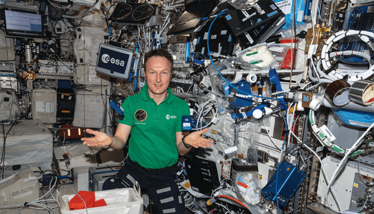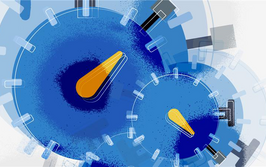Space Age
Assessing the effect of microgravity on the physiology of aging
Samantha W. Jones | | 5 min read | Future

The UK is in the midst of a major demographic transition, fuelled by falling fertility and mortality rates. The number of older adults (≥ 65 years) is projected to reach 17 million by 2044, representing what will then be 25 percent of the national population (1). This picture is certainly not unique to the UK. Demographic aging is a global phenomenon and it carries with it some major public health challenges.
Few conditions are more central to the erosion of independence in the elderly than sarcopenia – a severe, age-related loss of skeletal muscle mass and function. By the age of 70, it is estimated that muscle volume reduces by 25-30 percent, whilst strength diminishes by 30-40 percent (2). The significance of these figures cannot be overstated. Skeletal muscle is a critical regulator of whole-body metabolic health. Therefore, major pathological changes can have a profound effect on quality of life and health span (3).
Sarcopenia engenders both physiological and psychosocial impacts to the individual, as well as placing additional pressures on healthcare providers. Progressive loss of muscle mass and function contributes to physical frailty, social isolation, sedentarism, and chronic disease, which culminate into increased hospital admissions (4). These factors pose an important question as to the ability of our current medical infrastructure to meet the ever-increasing needs of the oldest strata of our society.
Muscle loss and microgravity
To those outside of the field it may be easy to assume that there are very few commonalities between human spaceflight and musculoskeletal aging. How could the extreme environment of space possibly be leveraged to inform us about muscle physiology and how it changes over a life course?
To the contrary, since the advent of human space exploration it has been established that exposure to microgravity has a negative impact on many physiological systems of the body, and none more so than the musculoskeletal system. It has been reported that after a mere 17 days in orbit, virtually all muscles decrease in volume within the order of 3–10 percent, with greater changes observed during longer periods of flight (5).
Currently, the best practice for maintaining muscle mass in microgravity relies upon regular bouts of aerobic and resistance training. On average, an astronaut living on board the International Space Station (ISS) will exercise for two hours per day. However, the preventative effects of this intense training regime remain incomplete (6). Interestingly, this is very similar to the anabolic resistance observed in elderly subjects who participate in resistance training on earth (7).
There is now considerable interest in the possibility that microgravity platforms could be used as accelerated models of skeletal muscle aging, under the rationale that common mechanisms potentially underlie the failure of the muscle to adapt appropriately to exercise, resulting in loss of mass and function in both situations.
The MicroAge missions
The Skeletal Muscle Research Group at the University of Liverpool, UK, spearheaded by Malcolm Jackson and Anne McArdle, have led several high-profile studies that aimed to address fundamental questions about the mechanisms of muscle loss in microgravity and how they relate to musculoskeletal aging on earth.
The MicroAge Mission, launched in December 2021, was a UK Space Agency (UKSA)-funded national mission to the ISS performed in partnership with a company called Kayser Space Ltd. The study assessed adaptations to contractile activity occurring in tissue-engineered skeletal muscle constructs exposed to microgravity.
Initial results indicated that contraction-mediated cytokine responses were attenuated in microgravity in a similar, albeit vastly accelerated, manner to that seen in aging muscle. It was concluded that changes to mitochondria, the key organelle responsible for the generation of energy in the cell, may underlie the failed adaptations to contractile activity, and ensuing muscle degradation.
Building upon the foundations of the MicroAge Mission, the research group was awarded a second UKSA-funded national mission, MicroAge II, in December 2022. This exciting new study, again partnering with Kayser Space Ltd, is anticipated to launch to the ISS in 2025.
MicroAge II will develop approaches to examine how skeletal muscle mitochondria change their shape, distribution, and function in microgravity. The study will also assess whether maintaining passive tension on the muscles can prevent their degeneration, further examining the impacts on mitochondrial form and function.
Research impact and terrestrial benefits
The UK government’s industrial strategy previously identified healthy aging as one of its “grand challenges.” Going forward, it is of utmost importance to harness the power of research and innovation to meet the needs of the country’s aging population, achieving the goal of “five more years of healthy aging” by 2035. Microgravity environments and analogues are a rich and relatively untapped resource for biological research, providing viable platforms from which to study accelerated aging phenotypes in skeletal muscle and other major organ systems. Such research activities have clear terrestrial benefits, extending from fundamental and mechanistic studies, right through to the identification of therapeutic targets and the development of new physiological interventions.
From a spaceflight perspective, the Artemis program is ushering in a new era of space exploration as humanity pushes boundaries by building a long-term presence on the moon by the end of the decade. The Artemis missions will build the foundations for supporting and sustaining life away from Earth, and as such it is important for us to understand the biological implications of such endeavours so that we may develop effective countermeasures to preserve the health of future spacefaring communities (8).
- N Coombs et al., “Living longer: is age 70 the new age 65?” (2019). Available at: https://bit.ly/3WIzMnx
- MJ Jackson, “On the mechanisms underlying attenuated redox responses to exercise in older individuals: A hypothesis”, Free Radic Biol Med, 161 https://doi.org/10.1016/j.freeradbiomed.2020.10.026
- KK Baskin et al., “Muscle as a “mediator” of systemic metabolism”, Cell Metab, 2-21 (2015). DOI: 10.1016/j.cmet.2014.12.021
- JD Walston, “Sarcopenia in older adults”, Curr Opin Rheumatol, 623-7 (2012). DOI: 10.1097/BOR.0b013e328358d59b
- A LeBlanc et al., “Bone mineral and lean tissue loss after long duration space flight”, J Musculoskelet Neuronal Interact, 157-60 (2000). PMID: 15758512
- T Lang et al., “Towards human exploration of space: the THESEUS review series on muscle and bone research priorities”, npj Microgravity 3-8 (2017). DOI: 10.1038/s41526-017-0013-0
- LG Hvid et al., “Aging impairs the recovery in mechanical muscle function following 4 days of disuse”. Exp Gerontol, 58. doi.org/10.1016/j.exger.2014.01.012
- M Chen et al., “Review of space habitat designs for long term space explorations”. Prog Aerosp Sci 122 (2021) doi.org/10.1016/j.paerosci.2020.100692
Department of Musculoskeletal and Ageing Science, University of Liverpool, UK



















